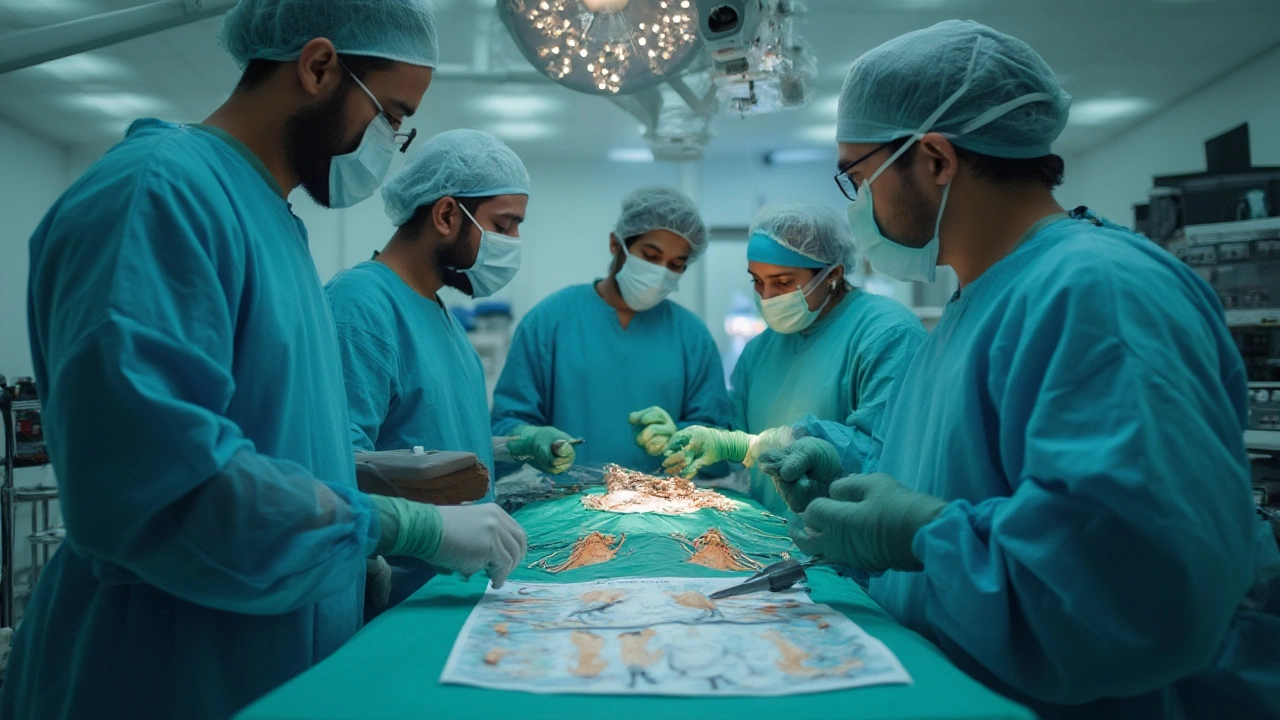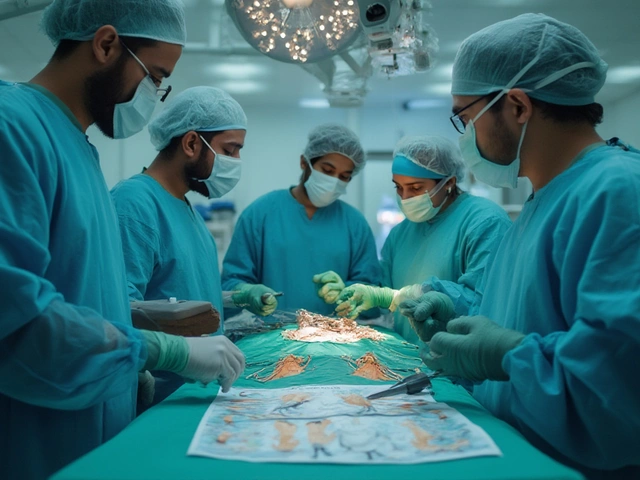Most people flinch at the word “surgery,” but when you attach it to “bone,” it really makes folks uneasy. It’s not just the procedure itself—bones are the body’s framework, and anything happening to them feels serious. Yet, for thousands every day, bone surgery is a lifeline that brings back movement, ends pain, or puts the pieces back together, literally.
What is Bone Surgery Called?
Let’s clear it up: bone surgery isn’t just one thing. The general medical term for bone surgery is “orthopedic surgery”—with doctors who perform it known as orthopedic surgeons. The more medical term for actually cutting and reshaping bones is “osteotomy.” If you’re talking about fixing a broken bone, “open reduction and internal fixation” (ORIF) describes a very common procedure. These names aren’t just fancy labels; they help your doctor explain what’s happening inside the operating room. For instance, my neighbor Arun tore his ACL playing football, and he needed an orthopedic surgeon—not just any surgeon—because his bones and ligaments had to be lined up right for future movement.
The roots of "orthopedic" go back to the 18th century, with the French word "orthopédie" meaning correct or straight child. But modern orthopedic surgery covers folks of all ages. Techniques range from repairing fractures, joining broken bones with hardware (think plates, rods), to removing bone tumors or correcting deformities. There’s even joint replacement—like getting a new hip when the old one has worn out. During some procedures, surgeons use tools a carpenter would envy: saws, screws, drills, and wires. It sounds wild, but this hardware gets people back on their feet way faster than you might guess.
For the science-obsessed, here’s a trick: most bone surgeries have a name with “osteo” (bone), such as “osteotomy” (cutting the bone), “osteosynthesis” (fixing with hardware), or “osteoplasty” (molding or shaping bone). So if you hear these words tossed around by a doctor, you know bone is involved. The scope of orthopedic surgery has widened so much that procedures now range from tiny finger repairs to rearranging large parts of your skeleton.
Types of Bone Surgery and Why They Happen
Not every bone injury needs surgery. Most fractures (broken bones) heal nicely in a cast or brace. Surgery enters the scene when the bone breaks in a tricky way—like splintering into many pieces, poking through the skin, or refusing to line up. Surgeons also step in for bone infections (osteomyelitis), bone tumors (some are harmless, others can be dangerous), or when the shape of the bone is doing more harm than good.
Here are the major types:
- Fracture Repair (ORIF): Plates, rods, or screws hold broken pieces together so they can heal straight. This is the bread-and-butter of orthopedic surgery.
- Osteotomy: Surgeons cut and realign a bone that's grown crooked or put under unusual stress—like bowlegs or knock knees.
- Arthroplasty: Replacing all or part of a joint, like a hip or knee. If you have arthritis chewing up cartilage, this is the fix.
- Bone Grafting: If there’s a gap from a serious injury or surgery, a piece of bone is moved from another spot or even a donor to fill it.
- Amputation: When disease or injury causes too much damage, part or all of a limb is removed. Surgeons do this as a last resort.
Want to see just how much bone surgery happens? Here’s a snapshot in the table below. These numbers are real and current as of last year:
| Procedure | Estimated Cases per Year (India) |
|---|---|
| Fracture Repair (ORIF) | 160,000 |
| Hip Replacement | 50,000 |
| Knee Replacement | 110,000 |
| Bone Tumor Removal | 12,000 |
| Bone Grafting | 21,000 |
To put this in perspective, that means every few minutes, someone in your city is having a bone put back together or replaced. Still, not everyone with a broken arm lands in the operating room. Lots of folks heal up with just a cast, especially kids (their bones knit together like magic—Simba, my cat, once broke her paw and bounced back in weeks).

The Journey: What Actually Happens During Bone Surgery?
People are often more scared of the unknown than of the surgery itself. Knowing what you’ll go through helps ease the nerves a bit. Before surgery, you’ll meet the orthopedic surgeon and the anesthesiologist—the doc who makes sure you don’t feel pain. You might get local anesthesia (numbs just the area), regional (numbs an arm or leg), or general anesthesia (you’re asleep). The choice depends on the size of the procedure and your health.
Once you’re squeaky clean in the surgical area, the surgeon maps out the bone using X-rays or scans. If they’re installing hardware, everything gets measured beforehand. The operation itself is pretty technical: Surgeons may make a cut over the bone, fix or remove the problem area, and use medical hardware to support the bone while it heals. Think of these as temporary scaffolds—the body does the real work, but sometimes it needs a bit of “cheating” to get started.
Most bone surgeries wrap up within 2-4 hours, but this can swing widely depending on how complex things get. For instance, putting together a shattered femur can take the better part of a morning, while realigning a finger bone is over before you finish a cup of tea. Afterward, patients usually spend a short time in recovery, often going home the same or next day—unless the injury or surgery is bigger.
Here’s a fun fact: Bones themselves can’t feel pain (they don’t have nerves), but the tissues around them do. So, while the actual cutting isn’t felt, it’s the “cleanup” and healing that sting. Docs give painkillers and advice on movement for comfort and to get you moving safely. Believe it or not, the goal isn’t to keep you in bed but to get you walking—sometimes with a walker or crutches—before you know it.
Recovery: Tips, Timelines, and What to Expect
If you ask anyone who’s had bone surgery, the operation feels like the easy part. Healing, on the other hand, takes patience. Most bone repairs heal in 6-8 weeks—sometimes less, sometimes more if there were complications. The younger the patient, the quicker the recovery (kids bounce, adults creep). Age, nutrition, and even whether you smoke all affect recovery speed.
Moving is the secret sauce. Early movement keeps joints from getting stiff and muscles strong. Your doctor might set you up with a physiotherapist right away. Ice helps with swelling, while elevating the limb (keeping it propped above your heart) cuts down on swelling. And eat well—protein, vitamin D, and calcium speed up bone healing.
Let’s debunk a myth: metal plates and screws usually don’t set off airport alarms or need to be removed (unless there’s a problem). Other tips:
- Take your antibiotics if prescribed. It’s much easier to prevent infection than treat it.
- If you notice fever, chills, or unusual pain, call your doc. These could hint at a brewing infection.
- Most wounds heal without issue, but keep the area dry and covered as your surgeon recommends.
- Don’t skip follow-up X-rays. They’re not just doctor’s busywork—they show if the bone is healing properly.
- Look after your mental health too. Surgery can be a lot, and it’s normal to feel anxious about recovery. Ask questions; stay engaged.
Simba, my ever-curious cat, didn’t need rehab, but people do. That’s where physiotherapists shine—they’re the folks who turn your “I’ll never walk again” into a 5K run six months later.

Frequently Asked Questions About Bone Surgery
bone surgery may sound intimidating, but let’s bust a few lingering concerns and myths so you’re not left at the mercy of imagination or internet horror stories. People often wonder: is it safe? Success rates for most elective orthopedic surgeries (like hip and knee replacements) hover above 95%. Complications like infection, bleeding, or hardware coming loose are possible but rare with modern care.
- Will I have a scar? Yes, but most fade over time.
- Do metal implants need changing? Rarely—most will last your lifetime.
- Can you walk after surgery? In many cases, yes—often much sooner than patients expect.
- Does weather affect hardware? Some folks claim they feel it in their bones before it rains, but studies don’t back this up concretely. Still, joints might ache with cold or humidity.
- How do I choose a good orthopedic surgeon? Look for someone with training from recognized medical boards, lots of experience with your specific problem, and reviews from real patients—not just polished hospital testimonials.
Bones heal, and so do people. If you—or someone you care about—is ever told they need bone surgery, know that what used to be impossible is now routine. Catch problems early, ask questions, and work on recovery like it’s your day job. Keep moving, stay positive, and there’s a solid chance you’ll be back doing what you love—maybe with a few stories about screws, scars, and new beginnings along the way.






